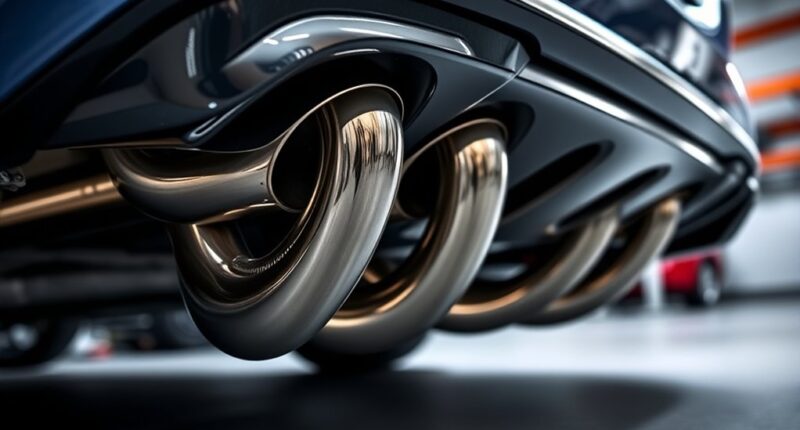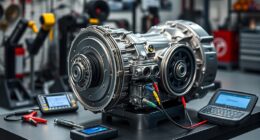Upgrading the downpipes on your Mercedes AMG C63 or E63 can boost horsepower, improve exhaust sound, and reduce restrictions for better performance. You can choose from options like high-flow catalytic converters, catless, or hybrid downpipes made from durable materials like stainless steel or titanium. Proper installation and tuning are essential to maximize gains and avoid issues. If you want to discover which upgrade best suits your vehicle, keep exploring the options available.
Key Takeaways
- Upgrading downpipes improves exhaust flow, increasing horsepower, torque, and engine responsiveness for Mercedes AMG C63 and E63.
- Choose from high-flow, catless, hybrid, or OEM options based on legality, performance goals, and material preferences like stainless steel or titanium.
- Proper installation and ECU tuning are essential to maximize performance gains and prevent error codes or exhaust leaks.
- Enhanced exhaust sound with deeper, more aggressive tones and crackles during deceleration; tuning optimizes sound and power.
- Investing in quality materials and professional tuning ensures durability, reliability, and long-term performance benefits.
Benefits of Upgrading Downpipes on AMG C63 and E63

Upgrading downpipes on your AMG C63 or E63 offers significant performance benefits by improving exhaust flow. When you install aftermarket downpipes, you reduce restrictions in the exhaust system, allowing gases to exit more efficiently. This results in increased horsepower and torque, giving your vehicle quicker acceleration and better overall performance. Additionally, upgraded downpipes often include high-flow catalysts or delete catalytic converters, which enhance exhaust flow even further. You may also notice a more aggressive exhaust sound, adding to your driving experience. Improved airflow helps the engine breathe better, potentially boosting fuel efficiency when paired with proper tuning. Incorporating performance enhancements strategies in your vehicle setup or garage can facilitate easier maintenance and upgrades, making the process smoother and more efficient.
Types of Aftermarket Downpipes for Mercedes AMG Models

When exploring aftermarket downpipes for Mercedes AMG models like the C63 and E63, you’ll find several types designed to enhance performance and sound. The main options include high-flow catalytic converters, catless downpipes, and hybrid designs. High-flow catalytic converters improve airflow while maintaining emissions compliance. Catless downpipes remove catalysts entirely, offering maximum performance gains and a more aggressive exhaust note. Hybrid options combine features of both, balancing performance with emissions. Here’s a quick comparison:
| Type | Pros |
|---|---|
| High-flow Catalytic | Better flow, still legal in some areas |
| Catless | Maximum performance, loud exhaust tone |
| Hybrid | Good balance of flow and legality |
| Standard OEM | Reliable, emissions compliant |
Additionally, emissions compliance can vary depending on the specific downpipe type and your location. Understanding performance gains and how they relate to your vehicle’s setup can help you choose the best option for your needs. It’s also important to consider aftermarket modifications, as they can impact your vehicle’s warranty and legal status. Being aware of regulations in your area ensures you stay within legal limits while upgrading your vehicle.
Material Choices and Their Impact on Performance
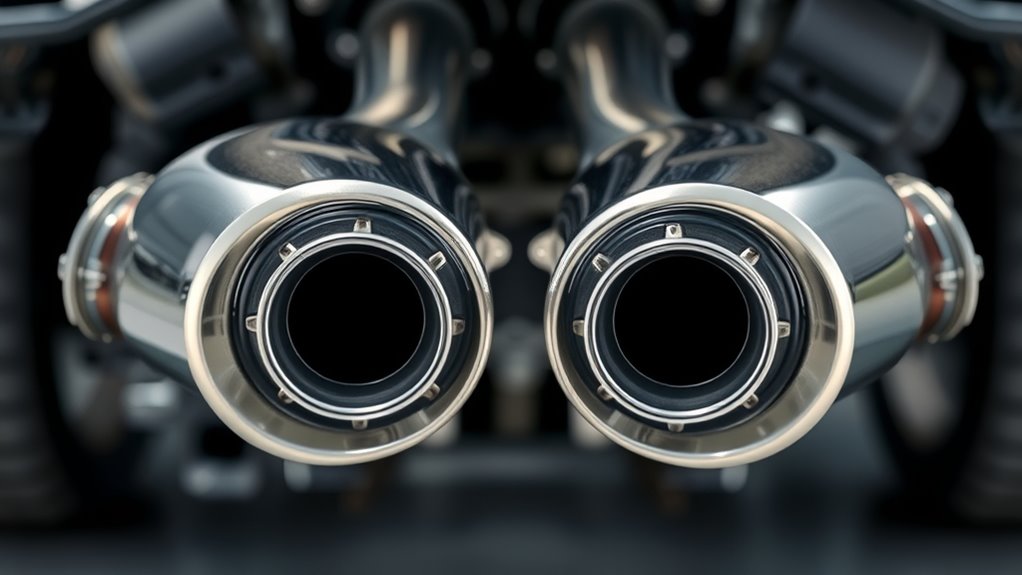
Choosing the right material for your aftermarket downpipes can considerably influence their performance, durability, and sound. Stainless steel, for example, offers excellent corrosion resistance and longevity, making it a popular choice for daily drivers. It also handles high temperatures well, ensuring consistent performance over time. Incorporating organic farming principles such as crop rotation and cover cropping can be beneficial when considering materials used in manufacturing or maintenance practices. Additionally, selecting environmentally conscious sustainable materials can enhance the overall ecological impact of your modifications. In contrast, titanium is lighter and can improve weight distribution, potentially enhancing acceleration and handling. However, it’s more expensive and less common. Ceramic-coated downpipes reduce heat transfer, which helps maintain engine efficiency and can improve exhaust flow, resulting in better power gains. Each material impacts sound, with stainless steel producing a deeper tone and ceramic coatings offering a quieter operation. Moreover, choosing lightweight materials can contribute to improved vehicle agility and efficiency. Your choice affects not just performance but also how your vehicle sounds and how long your downpipes last under demanding conditions.
Compatibility Considerations for Different Model Years
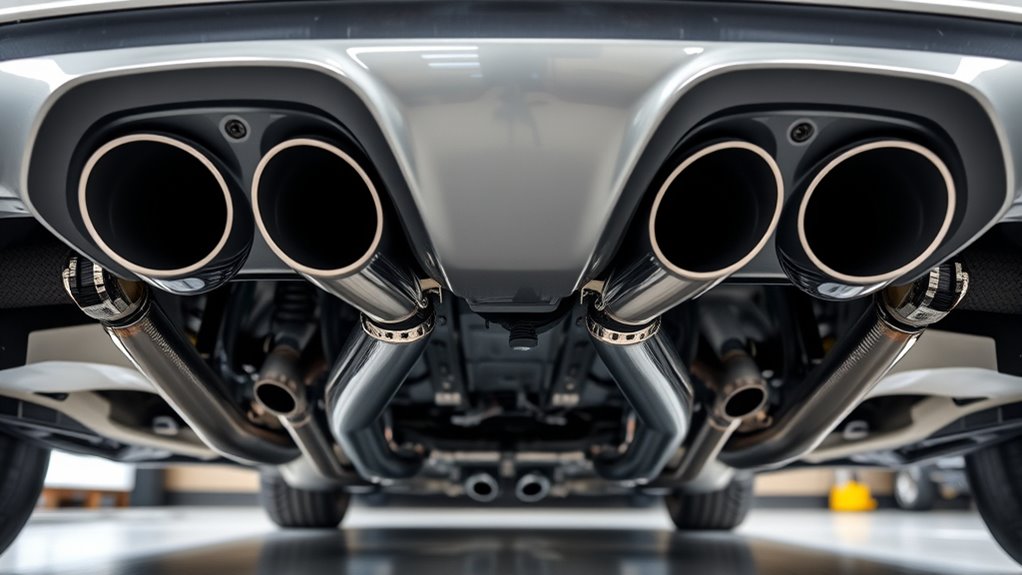
Model years can markedly influence the compatibility of aftermarket downpipes with your Mercedes AMG C63 or E63. Different model years often feature unique exhaust system configurations, sensor placements, and mounting points. A thorough understanding of professional help can assist in determining the best options for your specific vehicle. For example, certain pre-2017 models might require adapters or custom fittings to work correctly with newer downpipes, while later models could have integrated components that limit compatibility. Additionally, updates to emission standards or engine management systems across years can affect the fitment and performance of aftermarket parts. Recognizing model-specific differences is crucial to ensure proper installation and optimal performance. Being aware of year-dependent variations can also prevent costly mistakes and ensure your upgrade achieves the desired performance gains. Consulting manufacturer specifications or expert advice further ensures compatibility and safety of your modifications.
Installation Process and Tips for Success
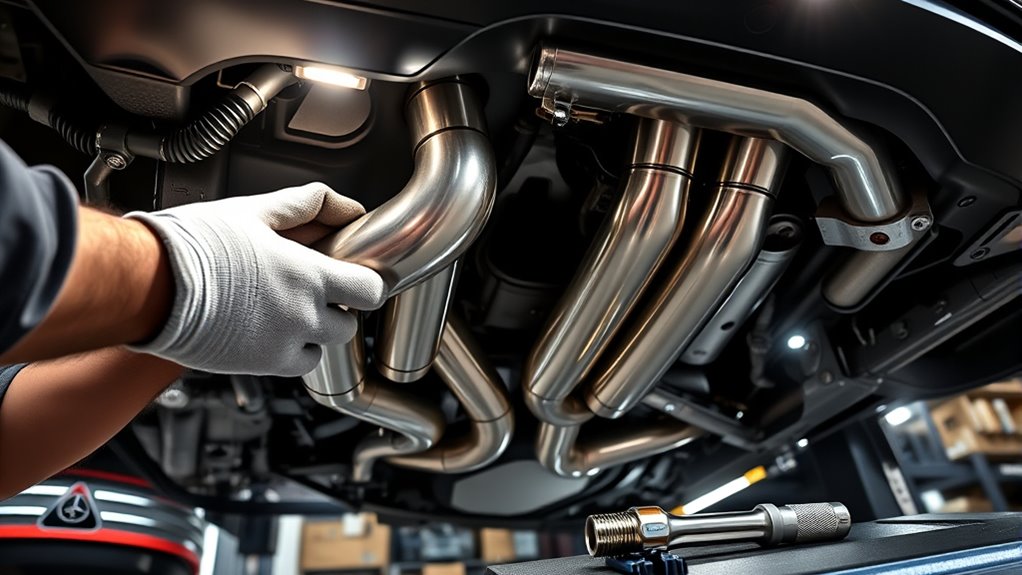
To guarantee a smooth installation, start by gathering all necessary tools and setting up a clean workspace. Follow a clear, step-by-step guide to avoid mistakes and save time. If issues come up, knowing common troubleshooting tips can help you resolve them quickly and confidently. Understanding cookie management and how it affects your browsing can also improve your online experience during the process. Additionally, familiarizing yourself with Mazda tuning concepts can provide insights into optimizing your vehicle’s performance during upgrades. Recognizing the importance of performance upgrades can help ensure your modifications achieve the desired results. Being aware of airless paint sprayer features can also assist in understanding how different components contribute to a successful upgrade.
Preparing Tools and Workspace
Before starting the installation, it’s essential to gather all the necessary tools and set up a clean, organized workspace. You’ll need basic hand tools like ratchets, sockets, and wrenches, as well as specialty tools such as a torque wrench and possibly a pry bar. Having a good quality flashlight or work light will help you see clearly in tight spots. Clear the area of clutter and verify your vehicle is on a flat surface with the parking brake engaged. Keep a container nearby for small parts and fasteners. Proper lighting and a tidy workspace will prevent mistakes and speed up the process. Double-check that you have all parts and tools before beginning to avoid unnecessary interruptions. Monitoring market trends can also help you time your upgrades for optimal performance. Additionally, ensuring your workspace is free of debris will help prevent damage to delicate components during the upgrade. Ensuring proper tool calibration can further improve installation accuracy and safety. It is also helpful to review installation instructions beforehand to familiarize yourself with the process. Taking the time to prepare your workspace carefully can lead to a smoother and more efficient upgrade experience.
Step-by-Step Installation Guide
Start by lifting the vehicle securely on jack stands or a lift to gain clear access underneath. Once elevated, loosen and remove the factory downpipes carefully, supporting the exhaust system as needed. Ensure proper handling of components to prevent damage during removal.
Align the new downpipes with the existing exhaust flanges and bolt them in place, ensuring all connections are tight. Use a torque wrench to tighten bolts to manufacturer specifications, avoiding over-tightening.
Double-check that all clamps and brackets are secure before lowering the vehicle.
- Gather all tools and parts beforehand
- Work in a clean, well-lit area
- Use penetrating oil on rusted bolts
- Test drive to verify proper fit and sound
Troubleshooting Common Issues
Even with careful installation, you might encounter common issues that can affect performance or sound. One frequent problem is exhaust leaks, which can cause rattling noises or reduce power. To fix this, double-check all clamps and connections, ensuring they’re tight and properly aligned.
Another issue is error codes or warning lights; these often occur if sensors aren’t connected correctly or if the ECU needs to adapt. Clearing codes with an OBD-II scanner and allowing the ECU to recalibrate can resolve this.
Additionally, some owners notice a drone or excessive noise at certain speeds. If this happens, consider installing sound-dampening accessories or adjusting the exhaust setup.
Regular inspection and proper torque on all fittings will help keep your upgrade performing smoothly and prevent future issues.
Potential Effects on Sound and Exhaust Note

Upgrading your downpipe can considerably alter the sound and exhaust note of your Mercedes AMG C63 or E63. You’ll notice a deeper, more aggressive tone that emphasizes your engine’s power.
Upgrading your downpipe gives your Mercedes AMG C63 or E63 a deeper, more aggressive exhaust sound.
The increased exhaust flow often results in a louder, more resonant sound during acceleration, giving your car a sportier presence. You might also experience a sharper crackle or pop on deceleration, enhancing the overall auditory experience.
Keep in mind, these changes can vary based on the downpipe design and your vehicle’s setup.
- Louder exhaust note with a more aggressive tone
- Enhanced crackles and pops during deceleration
- Deeper, more resonant engine sound
- Possible increase in drone at certain RPMs
Tuning and ECU Remapping After Downpipe Installation
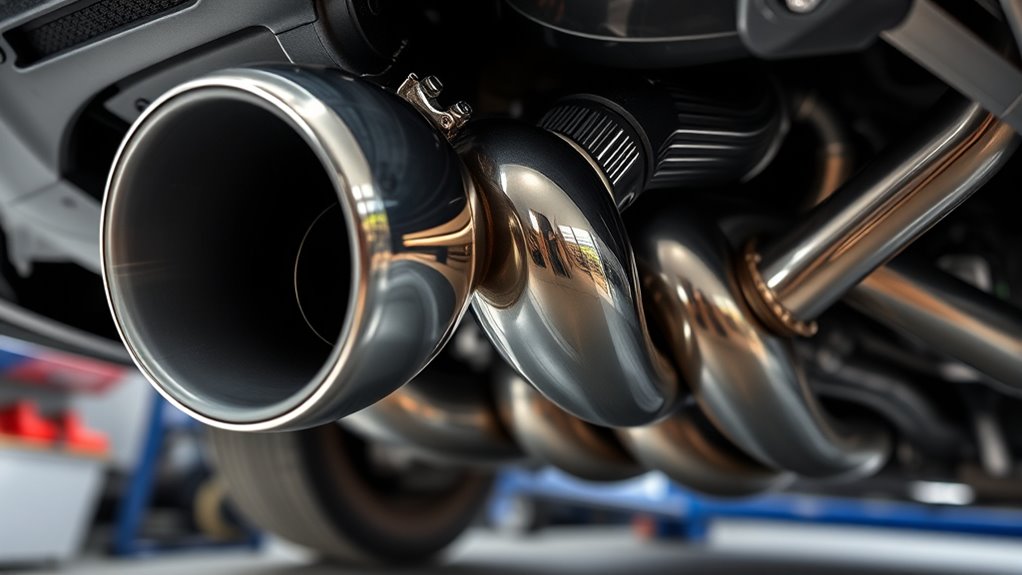
After installing a new downpipe, tuning and ECU remapping become essential to optimize your Mercedes AMG C63 or E63’s performance gains. Without proper tuning, you risk losing power or causing engine issues. Remapping adjusts the engine’s parameters, releasing the full potential of your upgrade. It also enhances throttle response, improves fuel efficiency, and ensures your vehicle runs smoothly under increased stress. To evoke the thrill of the upgrade, consider these emotional benefits:
| Feel the Power | Experience the Roar | Unlock Your Beast |
|---|---|---|
| Explosive acceleration | Deep, aggressive sound | Confidence on every drive |
| Enhanced responsiveness | Pure adrenaline rush | Pride in your ride |
| Peak performance | Unmatched driving pleasure | Mastery of your machine |
| Long-term reliability | Satisfaction guaranteed | Ultimate driving freedom |
Cost, Quality, and Choosing the Right Upgrade
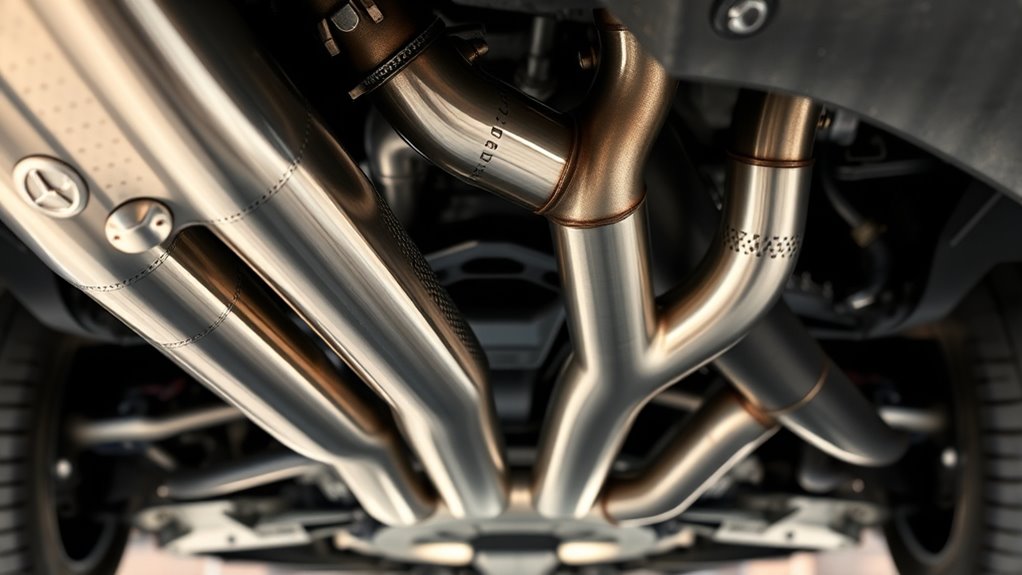
When selecting a downpipe upgrade, you need to think about both cost and quality to get the best value. Higher-quality materials often come with a higher price, but they can improve durability and performance.
Making the right choice means balancing your budget with the material and build quality that will last.
Cost Considerations
Considering the cost of upgrading your downpipe, it’s *essential* to balance quality with budget to make the right choice. Cheaper options may save you money upfront but can compromise durability and performance.
On the other hand, investing in higher-quality components might cost more initially but often provides better longevity and improved power gains. When evaluating costs, consider installation fees, compatibility, and potential tuning requirements.
Remember, a lower price doesn’t always mean a better deal if it results in frequent replacements or reduced performance. Focus on finding a balance that aligns with your goals and budget.
- Compare prices across brands and vendors
- Factor in installation and tuning costs
- Check for warranty and support options
- Prioritize value over lowest price
Material & Build Quality
Choosing the right material and build quality for your downpipe is essential because it directly impacts durability, performance, and long-term costs. High-quality materials like stainless steel or titanium resist corrosion, ensuring your downpipe stays in top condition longer.
Stainless steel, especially T304 grade, offers excellent strength and heat resistance at a reasonable price, making it a popular choice. Titanium is lighter and more durable but tends to cost more.
Poor-quality materials may crack or degrade faster, leading to costly replacements. When selecting a downpipe, verify the craftsmanship—welds should be clean and strong, with a precise fit.
Investing in a well-made, durable upgrade maximizes performance gains, reduces maintenance, and saves you money over time. Prioritize quality to get the most out of your vehicle’s upgrade.
Frequently Asked Questions
Do Downpipe Upgrades Void Mercedes AMG Warranty?
You might wonder if upgrading your downpipe voids your Mercedes AMG warranty. Generally, installing aftermarket parts can impact your warranty, especially if they cause damage or if Mercedes finds the part caused the issue.
However, if the upgrade doesn’t lead to problems and you keep records of the installation, you may still maintain your warranty. It’s best to check Mercedes’ specific policies and consult with your dealer before proceeding.
How Do Downpipes Affect Emissions Compliance?
You might think that upgrading downpipes improves performance without affecting emissions, but that’s not always true. Downpipes can substantially alter exhaust flow, potentially increasing emissions beyond legal limits.
While some upgrades are designed to stay within compliance, many modifications bypass emissions controls, risking penalties. Always verify local regulations and choose high-quality, compliant parts to ensure your vehicle remains environmentally responsible and legally compliant.
Can I Install Downpipes Myself or Need Professional Help?
You can install downpipes yourself if you have mechanical skills and the right tools. However, it’s often best to seek professional help to guarantee proper fitment and to avoid damaging components.
DIY installation might save money, but mistakes can lead to emissions issues or engine problems. If you’re unsure or inexperienced, it’s safer to let a qualified mechanic handle it for a smoother, hassle-free upgrade.
Are There Specific Brands Recommended for AMG Models?
Think of choosing a brand like picking a trusted map for a journey. For your AMG models, brands like Akrapovic, ARK Performance, and Edelbrock stand out as reliable guides. They’re known for high-quality materials and precision engineering, ensuring peak performance.
Stick with these names to navigate upgrades confidently, just like following a proven trail that leads to a smoother, more powerful ride without unnecessary detours.
How Often Should Downpipes Be Inspected or Replaced?
You should inspect your downpipes at least once a year or every 12,000 to 15,000 miles. This is especially important if you notice unusual noises, reduced performance, or increased exhaust smoke.
Replace them if you see rust, cracks, or significant damage. Regular checks help prevent costly repairs, keep your vehicle running smoothly, and guarantee your exhaust system remains efficient.
Staying proactive will extend the lifespan of your downpipes and maintain peak engine performance.
Conclusion
Upgrading your downpipes transforms your AMG C63 or E63 into an unstoppable symphony of power and precision. With improved airflow and a commanding exhaust note, you’ll feel like driving a beast liberated on the streets. Don’t settle for ordinary—embrace the extraordinary and elevate your driving experience to legendary status. The right upgrade isn’t just a modification; it’s your ticket to dominance, turning every drive into an epic performance that leaves everyone in awe.
